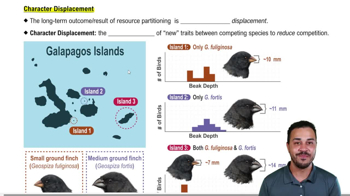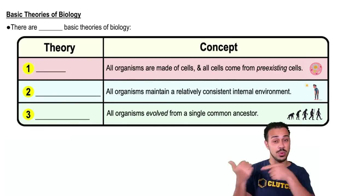Table of contents
- 1. Introduction to Biology2h 42m
- 2. Chemistry3h 40m
- 3. Water1h 26m
- 4. Biomolecules2h 23m
- 5. Cell Components2h 26m
- 6. The Membrane2h 31m
- 7. Energy and Metabolism2h 0m
- 8. Respiration2h 40m
- 9. Photosynthesis2h 49m
- 10. Cell Signaling59m
- 11. Cell Division2h 47m
- 12. Meiosis2h 0m
- 13. Mendelian Genetics4h 44m
- Introduction to Mendel's Experiments7m
- Genotype vs. Phenotype17m
- Punnett Squares13m
- Mendel's Experiments26m
- Mendel's Laws18m
- Monohybrid Crosses19m
- Test Crosses14m
- Dihybrid Crosses20m
- Punnett Square Probability26m
- Incomplete Dominance vs. Codominance20m
- Epistasis7m
- Non-Mendelian Genetics12m
- Pedigrees6m
- Autosomal Inheritance21m
- Sex-Linked Inheritance43m
- X-Inactivation9m
- 14. DNA Synthesis2h 27m
- 15. Gene Expression3h 20m
- 16. Regulation of Expression3h 31m
- Introduction to Regulation of Gene Expression13m
- Prokaryotic Gene Regulation via Operons27m
- The Lac Operon21m
- Glucose's Impact on Lac Operon25m
- The Trp Operon20m
- Review of the Lac Operon & Trp Operon11m
- Introduction to Eukaryotic Gene Regulation9m
- Eukaryotic Chromatin Modifications16m
- Eukaryotic Transcriptional Control22m
- Eukaryotic Post-Transcriptional Regulation28m
- Eukaryotic Post-Translational Regulation13m
- 17. Viruses37m
- 18. Biotechnology2h 58m
- 19. Genomics17m
- 20. Development1h 5m
- 21. Evolution3h 1m
- 22. Evolution of Populations3h 52m
- 23. Speciation1h 37m
- 24. History of Life on Earth2h 6m
- 25. Phylogeny2h 31m
- 26. Prokaryotes4h 59m
- 27. Protists1h 12m
- 28. Plants1h 22m
- 29. Fungi36m
- 30. Overview of Animals34m
- 31. Invertebrates1h 2m
- 32. Vertebrates50m
- 33. Plant Anatomy1h 3m
- 34. Vascular Plant Transport1h 2m
- 35. Soil37m
- 36. Plant Reproduction47m
- 37. Plant Sensation and Response1h 9m
- 38. Animal Form and Function1h 19m
- 39. Digestive System1h 10m
- 40. Circulatory System1h 57m
- 41. Immune System1h 12m
- 42. Osmoregulation and Excretion50m
- 43. Endocrine System1h 4m
- 44. Animal Reproduction1h 2m
- 45. Nervous System1h 55m
- 46. Sensory Systems46m
- 47. Muscle Systems23m
- 48. Ecology3h 11m
- Introduction to Ecology20m
- Biogeography14m
- Earth's Climate Patterns50m
- Introduction to Terrestrial Biomes10m
- Terrestrial Biomes: Near Equator13m
- Terrestrial Biomes: Temperate Regions10m
- Terrestrial Biomes: Northern Regions15m
- Introduction to Aquatic Biomes27m
- Freshwater Aquatic Biomes14m
- Marine Aquatic Biomes13m
- 49. Animal Behavior28m
- 50. Population Ecology3h 41m
- Introduction to Population Ecology28m
- Population Sampling Methods23m
- Life History12m
- Population Demography17m
- Factors Limiting Population Growth14m
- Introduction to Population Growth Models22m
- Linear Population Growth6m
- Exponential Population Growth29m
- Logistic Population Growth32m
- r/K Selection10m
- The Human Population22m
- 51. Community Ecology2h 46m
- Introduction to Community Ecology2m
- Introduction to Community Interactions9m
- Community Interactions: Competition (-/-)38m
- Community Interactions: Exploitation (+/-)23m
- Community Interactions: Mutualism (+/+) & Commensalism (+/0)9m
- Community Structure35m
- Community Dynamics26m
- Geographic Impact on Communities21m
- 52. Ecosystems2h 36m
- 53. Conservation Biology24m
1. Introduction to Biology
Scientific Method
Problem 6`
Textbook Question
Which of the following is an example of qualitative data?
a. The fish swam in a zigzag motion.
b. The contents of the stomach are mixed every 20 seconds.
c. The temperature decreased from 20°C to 15°C.
d. The six pairs of robins hatched an average of three chicks each.
 Verified step by step guidance
Verified step by step guidance1
Understand the difference between qualitative and quantitative data. Qualitative data describes qualities or characteristics, often using descriptive language, while quantitative data involves numbers and measurements.
Examine option a: 'The fish swam in a zigzag motion.' This statement describes the pattern of movement without using numbers, making it qualitative data.
Examine option b: 'The contents of the stomach are mixed every 20 seconds.' This statement uses a numerical measurement (20 seconds), indicating quantitative data.
Examine option c: 'The temperature decreased from 20°C to 15°C.' This statement involves numerical values (20°C and 15°C), indicating quantitative data.
Examine option d: 'The six pairs of robins hatched an average of three chicks each.' This statement uses numerical values (six pairs, three chicks), indicating quantitative data.
 Verified video answer for a similar problem:
Verified video answer for a similar problem:This video solution was recommended by our tutors as helpful for the problem above
Video duration:
2mPlay a video:
Was this helpful?
Key Concepts
Here are the essential concepts you must grasp in order to answer the question correctly.
Qualitative Data
Qualitative data refers to non-numeric information that describes characteristics or qualities. It is often used to capture observations that are subjective, such as behaviors, patterns, or descriptions. In the context of the question, qualitative data is exemplified by the description of the fish swimming in a zigzag motion, as it conveys a pattern without numerical measurement.
Recommended video:
Guided course

Character Displacement
Quantitative Data
Quantitative data involves numerical values that can be measured and quantified. This type of data is used to express quantities, amounts, or ranges, and is often used for statistical analysis. In the question, options b, c, and d represent quantitative data, as they provide specific numerical measurements or averages.
Recommended video:
Guided course

Character Displacement
Data Collection in Biology
Data collection in biology involves gathering information to understand biological processes and phenomena. It can include both qualitative and quantitative data, depending on the research focus. Qualitative data helps describe behaviors and patterns, while quantitative data provides measurable evidence. Understanding the type of data collected is crucial for interpreting biological studies and experiments.
Recommended video:
Guided course

Distal Tubule and Collecting Duct
Related Videos
Related Practice














